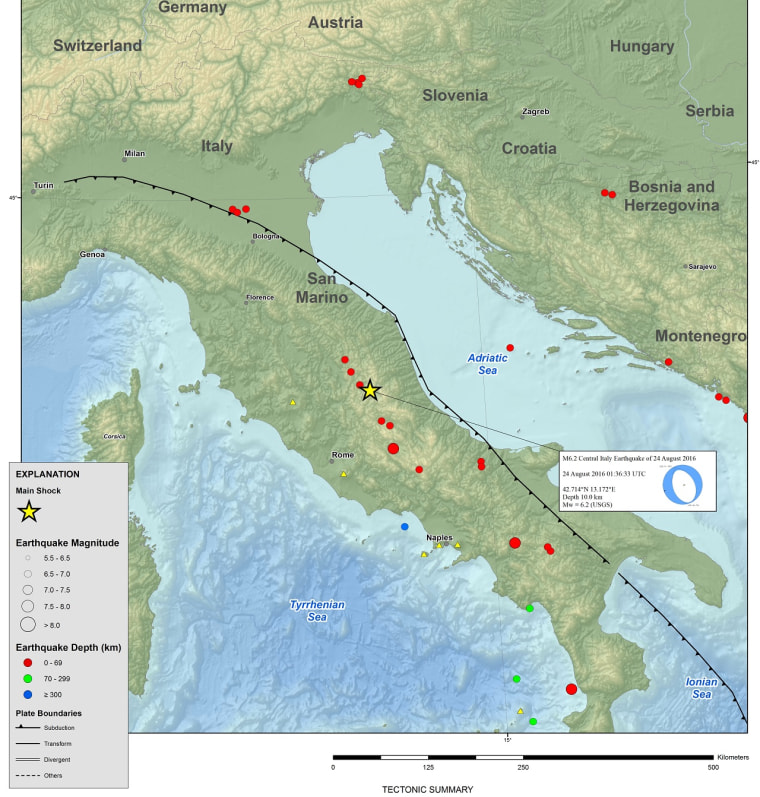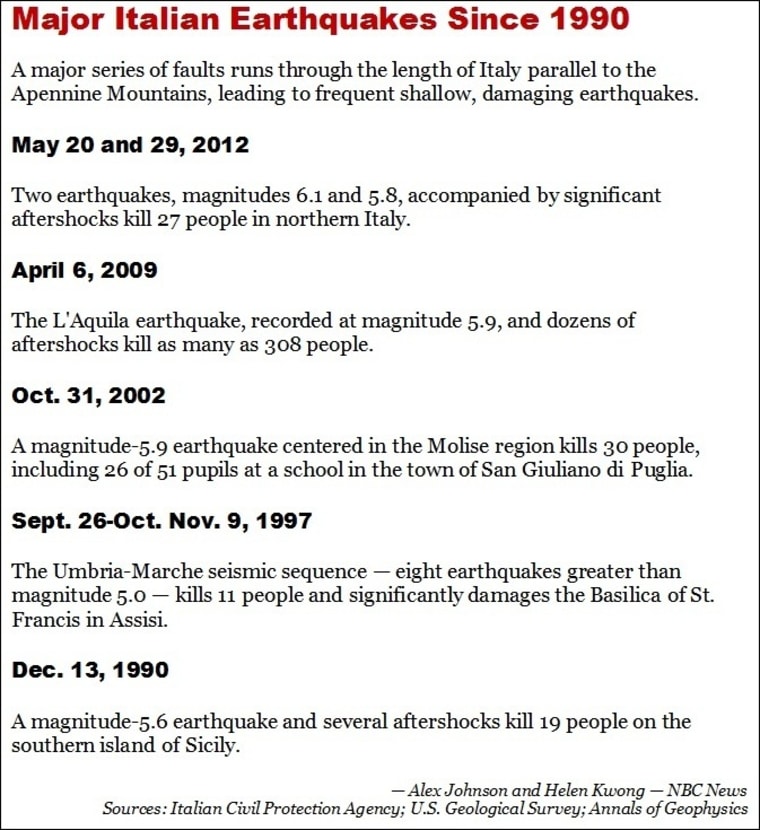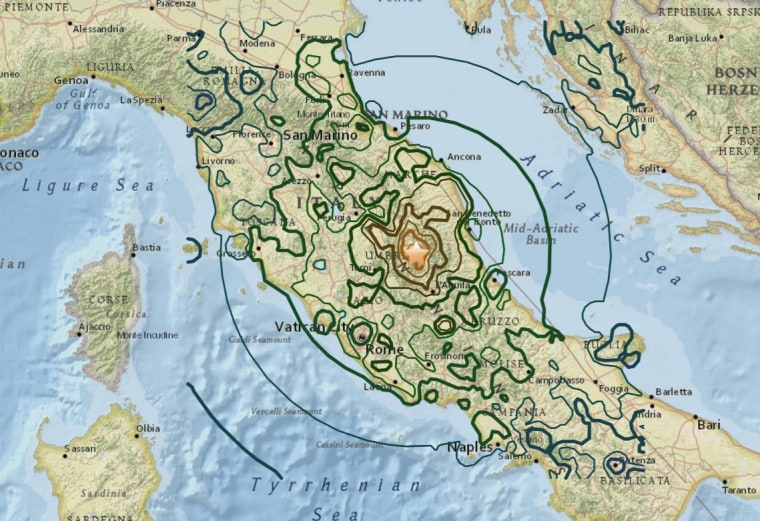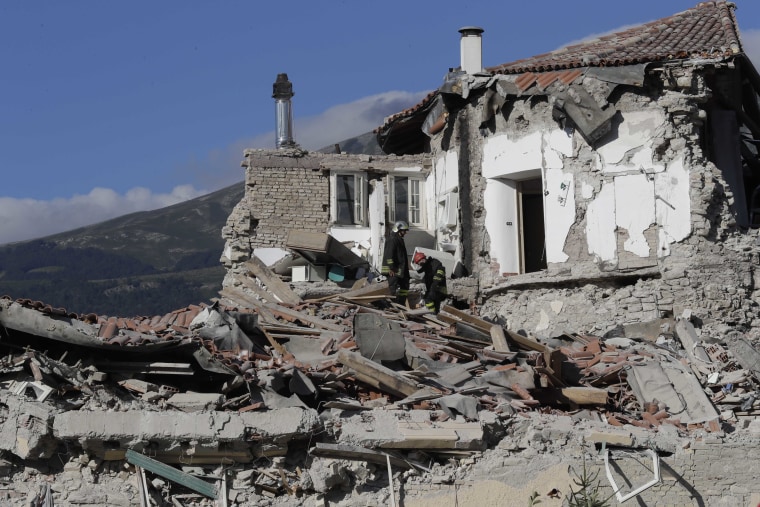The earthquake that killed at least 250 people in the middle of the night in central Italy was no surprise, experts said Wednesday.
After all, it was created by the same complex forces that gave birth to the mighty Alps beginning three-quarters of a billion years ago.
The shorthand explanation is that while Italy is politically part of Europe, geographically it's an extension of the African tectonic plate — one of the major sub-layers of the Earth's crust that have floated and skittered into one another for hundreds of millions of years.
The boundary of the African plate bumps up against the European plate, which is pushing it down — a process called subduction. Over geologic time, this slow but inevitable crunch of plates creates mountain ranges and volcanoes.
Besides the Alps, the collision of plates running through and around Italy is responsible for the Apennines, the mountain range that stretches like a spine for the length of Italy, said Horst Rademacher, a geophysicist with the University of California-Berkeley Seismological Laboratory.

A series of earthquake faults runs parallel to the Apennines in the central part of Italy, along which Wednesday's earthquake occurred. It's the same area where the 2009 L'Aquila earthquake, which killed more than 300 people, took place — in fact, the epicenters of the two events are less than 25 miles apart, Rademacher wrote Wednesday on Cal's Seismo Blog.
The U.S. Geological Survey calls this region one of the most complex on the planet, causing "the expression of all different tectonic styles acting at the same time in a broad region surrounding Italy and the central Mediterranean."
It's "one continent into another," said David Rothery, a professor of planetary geosciences at the Open University in Milton Keynes, England. "Italy's riddled with faults — the stress builds up and up until something gives way."
The central Apennine region is a particular hotbed for earthquakes, which are usually accompanied by a cluster of sizable aftershocks. The L'Aquila earthquake, for example, was followed by five aftershocks of magnitude 5.0 or larger.

And in 1997, the region suffered what's called the Umbria-Marche seismic sequence — eight earthquakes greater than magnitude 5.0 in just two months. Eleven people died, and the Basilica of St. Francis in Assisi was significantly damaged.
Rothery said seismologists have already recorded "all kinds of aftershocks carrying on" after Wednesday morning's quake, adding: "That's quite normal."
"As far as today's earthquake in Italy is concerned, the biggest human dangers now are aftershocks and landslides in this mountainous region," said Ben van der Pluijm, the Bruce R. Clark professor of geology at the University of Michigan.

Making matters worse is that central Apennine fault systems are short — leading to earthquakes that top out at "only" magnitude 6.8 to 7.0 but which occur at notably shallow depths.
The closer the center of an earthquake is to the surface, the harder the ground shakes. Wednesday's quake was centered just 6 miles underground; by comparison, a much stronger, magnitude-7.8 earthquake in Iran in April 2013 killed far fewer people, 35, mainly because it was centered 51 miles deep below the Earth's surface.
Related: Scenes From Italy's Earthquake: The Ancient Town of Amatrice Turned to Rubble
This amplified shaking is especially problematic in Italy, which is not only home to hundreds of historic, ancient monuments and palazzi but is also a country where many packed cities feature residential buildings and municipal structures, like bridges and roads, that are decades or even centuries old.
"The impacts of this earthquake will also be expensive," van der Pluijm said.
How expensive?
Brendan Duffy, Mark Quigley and Mike Sandiford, geologists at the University of Melbourne in Australia, noted Wednesday that parts of Norcia — where Wednesday's earthquake was centered — were built on top of the surface rupture created by an earthquake on the same fault line that seismologists estimate would have registered at magnitude 6.7 in today's terms.
They estimated that the damage from Wednesday's quake and its aftershocks would "almost inevitably" exceed $100 million — and it "may top $1 billion," they said.

